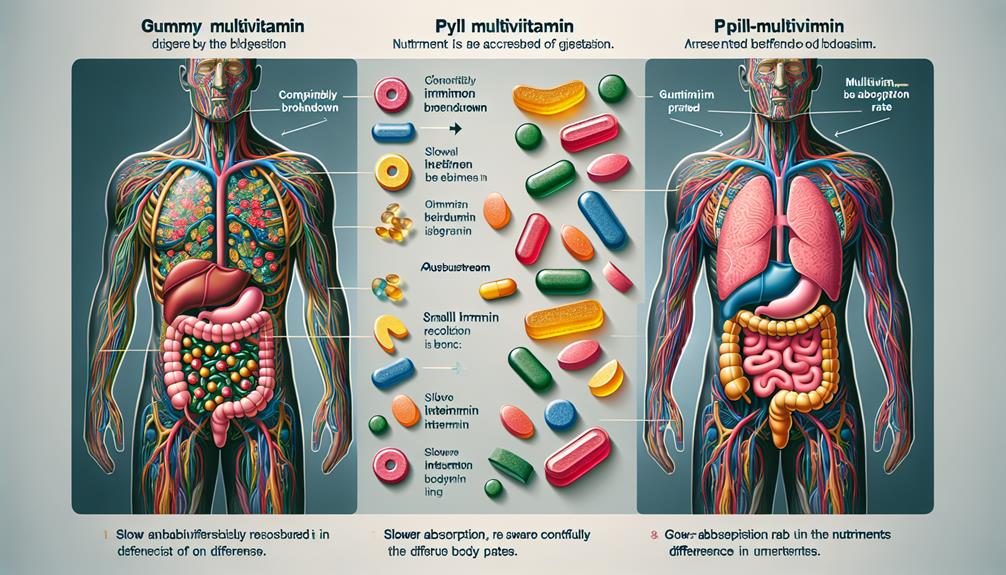







Gummy multivitamins, appealing as they are, lack the diverse nutrient content and absorption efficiency of pill-form multivitamins. Pills offer a more thorough nutrient profile and better absorption, impacting their overall effectiveness in meeting daily dietary needs. Consider your nutrient requirements and absorption preferences when choosing between gummy and pill multivitamins. The decision hinges on factors like taste, texture, and price, along with your health goals and convenience. Choosing the right form is vital for maximizing the benefits of your multivitamin supplementation. Make an informed choice based on what suits your needs best.
Key Takeaways
- Gummy vitamins may have lower absorption rates due to their gel-like consistency.
- Pill-form multivitamins undergo absorption testing, ensuring higher bioavailability.
- Pill-form multivitamins offer a wider range of nutrients compared to gummy vitamins.
- Gummy multivitamins are favored for taste, but may lack nutrient absorption efficiency.
- Consider individual needs and preferences for optimal multivitamin effectiveness.
Key Differences Between Gummy and Pill Multivitamins
When comparing gummy and pill multivitamins, it is essential to understand the key differences that exist between the two forms of supplementation. Taste preference and consumption habits play a significant role in determining which form of multivitamin is more suitable for individuals. Gummy vitamins are often favored for their fruity flavors and chewy texture, making them more appealing to those who struggle with swallowing pills. On the other hand, pills are generally tasteless and may be easier to consume for individuals who prefer a quick and straightforward method of supplementation.
Dietary restrictions can also influence the choice between gummy and pill multivitamins. Gummy vitamins may contain added sugars and gelatin, making them unsuitable for individuals following specific dietary requirements. Pills, on the other hand, are often free from these additives, catering to a wider range of dietary restrictions. Additionally, the convenience factor of gummy vitamins, which can be taken without water and are easily portable, may appeal to individuals who are constantly on the go.
Nutrient Content Comparison: Gummy Vs. Pill
The comparison of nutrient content between gummy and pill multivitamins reveals significant differences in their formulations and bioavailability. When looking at nutrient comparison, pill-form multivitamins tend to contain a wider variety of vitamins and minerals in higher amounts compared to gummy vitamins. This is due to the limitations of gummy vitamins regarding space and stability, which can restrict the amount and variety of nutrients that can be included. Additionally, the absorption rates of nutrients from gummy vitamins may differ from those in pill form due to various factors such as the presence of certain binding agents and coatings in pills that aid in the absorption process. While both gummy and pill multivitamins provide essential nutrients, pill-form multivitamins generally offer a more diverse nutrient profile and potentially higher absorption rates than gummy vitamins. It is crucial to take these factors into account when choosing between gummy and pill multivitamins based on individual nutrient needs and absorption preferences.
Absorption Rates in the Body

Optimizing nutrient absorption from multivitamins is essential for maximizing their effectiveness in supporting overall health and well-being. When comparing gummy and pill-form multivitamins, absorption rates play a vital role in determining the bioavailability of essential nutrients. Gummy multivitamins may face challenges in terms of absorption rates due to their composition, which can impact how efficiently the body absorbs the nutrients they contain.
The bioavailability of nutrients refers to the amount and rate at which they are absorbed and utilized by the body. Pill-form multivitamins often undergo thorough testing to make sure excellent absorption rates, whereas gummy vitamins may have variations in bioavailability depending on factors such as the presence of certain ingredients like gelatin or added sugars.
While gummy multivitamins offer benefits such as being easier to consume for individuals who struggle with swallowing pills, their absorption rates may be impacted by factors that could affect their overall effectiveness in delivering essential nutrients to the body. Consider these aspects when choosing between gummy and pill-form multivitamins to make sure you are getting the most out of your supplementation routine.
Efficacy of Gummy Multivitamins
To evaluate the effectiveness of gummy multivitamins, it is vital to take into account their influence on nutrient absorption and overall health outcomes. Gummy multivitamins are favored by many due to their appealing flavors, which can enhance compliance, particularly in individuals who struggle with swallowing pills. However, the bioavailability of nutrients in gummy multivitamins may differ from pill-form multivitamins. The gel-like consistency of gummies might impact the release and absorption of vitamins and minerals in the body compared to traditional pills. Despite this potential difference, gummy multivitamins remain a convenient option for those who find them easier to consume regularly. Convenience plays an essential role in maintaining adherence to a supplement regimen, ultimately affecting the efficacy of the product. While gummy multivitamins offer a flavorful and convenient alternative to pill-form multivitamins, it is crucial to take into account their impact on nutrient bioavailability and overall health outcomes.
Effectiveness of Pill-Form Multivitamins

Exploring the effectiveness of pill-form multivitamins involves taking into account their impact on nutrient absorption and health outcomes compared to other delivery forms. Clinical studies have shown that pill-form multivitamins can have high bioavailability, meaning the body can absorb and utilize the nutrients effectively. This is vital for guaranteeing that the vitamins and minerals are beneficial to your health.
In comparison to gummy multivitamins, pill-form multivitamins often contain a wider range of nutrients due to their ability to withstand more ingredients and higher concentrations. This can be advantageous for individuals with specific dietary deficiencies or health concerns. Additionally, pill-form multivitamins are commonly preferred by consumers who prioritize convenience, as they are easy to store and transport without the risk of melting or sticking together.
When selecting between gummy and pill-form multivitamins, it is essential to take into account your individual needs and preferences. While gummy vitamins may be appealing due to their taste and texture, pill-form multivitamins offer a dependable and effective way to make sure you are meeting your daily nutrient requirements.
Factors Affecting Bioavailability
Considering the impact of different delivery forms on nutrient absorption, various factors can influence the bioavailability of vitamins and minerals in multivitamins. Factors affecting absorption include the chemical form of the nutrient, the presence of other nutrients that may enhance or inhibit absorption, the individual's health status and age, the presence of certain medical conditions affecting gut health, and the overall diet. For instance, the presence of fat can enhance the absorption of fat-soluble vitamins like Vitamin D, A, E, and K. On the other hand, some minerals may compete for absorption when present in high doses. Bioavailability comparisons show that certain formulations, such as those in liquid or gummy form, may have higher bioavailability due to easier digestion and absorption. However, individual differences in metabolism and digestive health can also play a significant role in how effectively the body absorbs and utilizes the nutrients provided in multivitamins.
Suitability for Different Age Groups

The suitability of multivitamins for different age groups varies based on specific nutrient needs and absorption capabilities. Age-specific benefits play a vital role in determining the most suitable multivitamin formulation. For example, children may benefit from gummy multivitamins due to their attractive taste and chewable format, making it easier for them to consume. Additionally, gummy vitamins are often fortified with vitamin D and calcium, which are essential for growing bones. On the other hand, older adults may require pill-form multivitamins that are specifically tailored to their needs, such as higher levels of B vitamins for energy production and bone-strengthening nutrients like vitamin K.
Dosage variations are another key factor to take into account when selecting multivitamins for different age groups. Children typically require lower dosages of vitamins and minerals compared to adults, making gummy multivitamins a suitable option for meeting their nutritional needs without the risk of overdose. In contrast, adults may benefit from pill-form multivitamins that can provide higher concentrations of essential nutrients to support their overall health and well-being. Ultimately, choosing the right multivitamin formulation based on age-specific benefits and dosage variations is essential for optimizing health outcomes across different age groups.
Taste and Texture Considerations
When choosing between gummy and pill-form multivitamins, taste and texture considerations play a vital role in enhancing overall user experience and compliance. Texture preferences can vary widely among individuals, with some favoring the chewy consistency of gummy vitamins over the usual hardness of pill-form alternatives. Gummy multivitamins often offer a more pleasant and easier consumption experience, particularly for those who struggle with swallowing pills.
Taste profiles are another essential factor to take into account when deciding between gummy and pill-form multivitamins. Gummy vitamins are available in a variety of flavors, ranging from fruity to sour, catering to different taste preferences. On the other hand, pill-form multivitamins may lack flavoring or coating, which can make them less appealing to certain individuals, especially children.
Ultimately, the taste and texture of multivitamins can have a significant impact on user satisfaction and adherence to a supplement regimen. By understanding your texture preferences and taste profiles, you can make an informed decision that aligns with your personal preferences and improves your overall experience with multivitamin consumption.
Price Comparison: Gummy Vs. Pill

Texture preferences and taste profiles influence your choice between gummy and pill-form multivitamins, and now, shifting focus to the comparative aspect, let's explore the price differences between these two forms. Cost comparison is a significant factor when deciding between gummy and pill-form multivitamins. Generally, gummy multivitamins tend to be more expensive per serving compared to pill-form multivitamins. The manufacturing process for gummies often requires additional steps to create the desired taste and texture, which can drive up the cost. Additionally, the ingredients used in gummy multivitamins may differ from those in pill-form multivitamins, contributing to the cost variance.
Brand preferences also play a role in the price variation between gummy and pill-form multivitamins. Some well-known brands may price their gummy multivitamins higher due to factors such as brand recognition, marketing expenses, and perceived quality. Conversely, store brands or lesser-known brands may offer more affordable options for both gummy and pill-form multivitamins. When considering price, it is essential to weigh the cost against factors like convenience, taste, and personal preferences to make an informed decision.
Recommendations for Choosing the Right Form
For ideal decision-making regarding the choice between gummy and pill-form multivitamins, take into account your specific dietary needs and preferences. When assessing gummy versus pill-form multivitamins, factors such as flavor preference and nutritional value play an important role. Gummy vitamins are often more appealing to those who struggle with swallowing pills due to their fruity flavors and chewy texture. However, it's vital to note that gummies may contain added sugars and calories that pill-form vitamins do not. On the other hand, pill-form multivitamins are typically free from added sugars and calories, ensuring a more straightforward approach to supplementation with a focus on essential nutrients.
Texture preference is another aspect to take into consideration. Some individuals may prefer the quick and easy consumption of pill-form vitamins, while others enjoy the experience of chewing gummy vitamins. Additionally, the convenience factor plays a significant role. Pill-form vitamins are generally more portable and have a longer shelf life compared to gummies, which can be prone to melting or sticking together in humid environments. Ultimately, the choice between gummy and pill-form multivitamins should align with your personal preferences and lifestyle needs.





